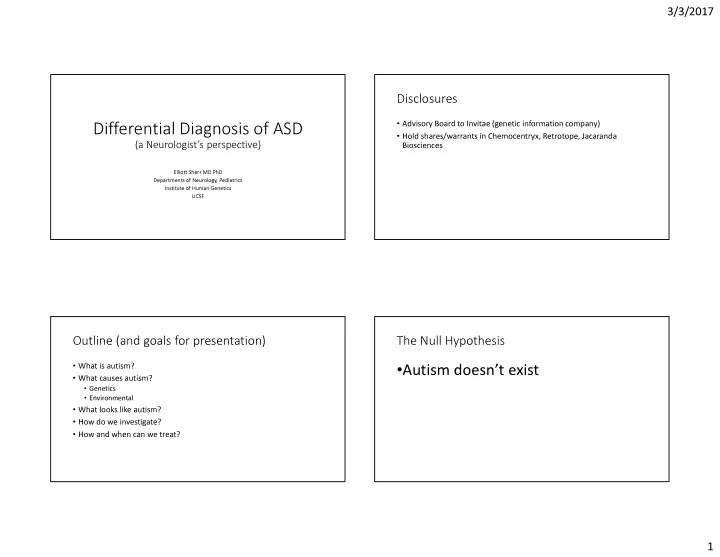

3/3/2017 Disclosures • Advisory Board to Invitae (genetic information company) Differential Diagnosis of ASD • Hold shares/warrants in Chemocentryx, Retrotope, Jacaranda (a Neurologist’s perspective) Biosciences Elliott Sherr MD PhD Departments of Neurology, Pediatrics Institute of Human Genetics UCSF Outline (and goals for presentation) The Null Hypothesis • What is autism? • Autism doesn’t exist • What causes autism? • Genetics • Environmental • What looks like autism? • How do we investigate? • How and when can we treat? 1
3/3/2017 The mirror image hypothesis Functional Model • Autism is a singular biological entity Clinical Manifestations of Autism Standardized Clinical Measurements Autism “biomarkers” Imaging, EEG etc G x E Interactions Primary Causes of Autism Genetics, Environment When to think: will the diagnosis impact care? Approximate Breakdown of ASD Causes (or when is this not just idiopathic non-progressive ASD/GDD?) • The Null Hypothesis: ALWAYS!! • A range of clinical features give added weight to this • Regression (or late onset) , Encephalopathy Monogenic/Idiopathic (10%) • Seizures, other neurologic manifestations, such as movement disorders, Syndromic (10%) spasticity, weakness, hemiparesis • Exam findings : Dysmorphic features, macro or microcephaly, Idiopathic Polygenic (50%) organomegaly, skin findings, etc Other (E, GxE) (30%) • Involvement of other functional systems : e.g. horseshoe kidney, cardiac malformation • Positive Family History 2
3/3/2017 The work up for ASD/GDD Imaging Findings that are actionable Any of the aforementioned red flags increases the need for this type of evaluation Referral to a neurologist for Findings on brain imaging further evaluation Broad based "first pass" If these evaluations are all Refer to a clinical geneticist includes brain MRI, EEG, negative, would consider microarray, Fragile X and whole exome and “Exome Clinic” biochemical evaluation sequencing IF biochemical testing is revealing, may need Referral to a metabolic additional testing, eg specialist mitochondrial genome testing X-Linked Adrenoleukodystophy Focal Cortical Dysplasia Left Hemisphere Stroke Whole Exome Sequencing Rare but Treatable Causes (examples) • Phenylketonuria (PKU) • Tested for in newborn screens throughout the U.S. and most of developed world • 50+ conditions screened for in the U.S., 12 in Germany and 2 in the U.K. gDNA • Presentation: ASD/ID, Irritability, Seizures, hypopigmentation • Easily treated with dietary restriction of phenylalanine • Should ALWAYS consider in child born outside of the US • Arginase deficiency • Presents with progressive but slow loss of function • Analogous to ASD regression • Also notable for progressive spasticity • Partially treatable by early diet intervention • Creatine Deficiency Syndromes • Pyridoxine Dependent Epilepsy (along with regression and ASD features) • NMDA receptor encephalopathy Johnsen J M et al. Blood 2013;122:3268-3275 3
3/3/2017 De Novo Mutations in Developmental Genetic Findings that are actionable Disorders • KNOWN SYNDROME Potential off-label intervention Genetic Findings that are actionable (beginnings of “precision medicine”) • Novel Syndrome 4
3/3/2017 Parents form support/research groups Genetic Findings that are actionable • Incidental, but essential findings Study of Monogenic Causes Leads to Advances: Monogenic (or genetic locus) ASD Causes Example:16p11.2 del/dup ( some common examples ) • Syndromic • Fragile X • 45% of FXS Males have ASD; 15% of FXS Females have ASD • 80% of FXS Males have ID • Rett Syndrome • >40% of Rett syndrome patients have ASD • >90% of Rett syndrome patients have ID • Tuberous Sclerosis • 40% approximately exceeded ASD threshold cut off • >many had more social deficits and less repetitive behviors • Non-syndromic single gene/genetic loci causes • Copy number variants • 16p11.2, 15q11-q13, 22q11.21, • Single gene • ANK2, ARID1B, CHD2, CHD8, DYRK1A, GRIN2B, SCN2A 5
3/3/2017 Mechanisms—integrating poly and mono genetic Del and Dup: Clinical Similarity, Imaging Differences CNTL DEL DUP Novel Treatments Future Directions • Ongoing trials • Genetics and other platforms to develop “early diagnosis” leading to • Transcranial Direct Current early behavioral interventions • Neurofeedback • Whole genome sequencing at birth/during pregnancy • Neuropeptides (administered intranasally) • Cell free DNA of developing fetus • Oxytocin • Therapies targeted to help correct biochemical deficiencies • Vasopressin • Enzyme replacement for storage disorders • Advances in gene therapy, “genome editing--CRISPR” approaches to • New techniques that aim to cross the blood-brain barrier correct mutations for many genes • Placement of reservoirs for intrathecal access • Gene therapy in early stages • Trials that did not meet with success • R-baclofen • Questions: elliott.sherr@ucsf.edu; 415-514-9306. • mGLuR agonists 6
Recommend
More recommend